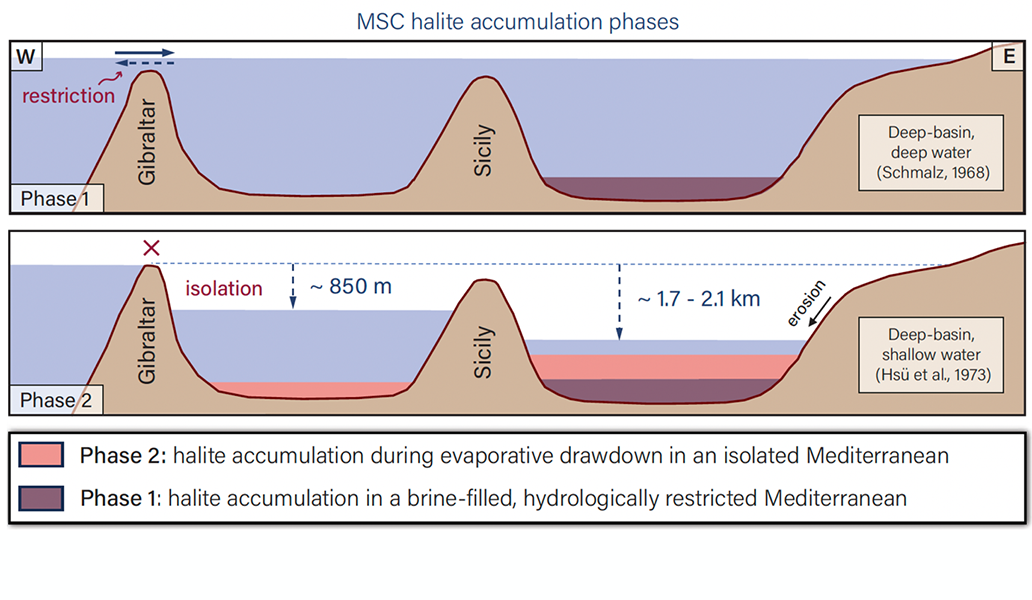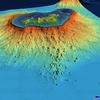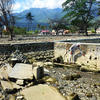You are here
When the Mediterranean was empty

This dramatic event in the history of the Mediterranean region is today known as the Messinian salinity crisis. This episode, identified in the 1970s following the discovery of enormous salt and gypsum deposits measuring up to 3 kilometres in thickness, dates back 5.33 to 5.97 million years, and attests to a severe hydrological crisis, which at its height dried up vast portions of the basin. How did this cataclysm occur? What caused it? What were its consequences, especially on the ecosystem? These questions are the subject of a new study1 led by researchers from the CNRS and the Paris Institute of Planetary Physics (IPGP)2, published in the journal Nature Communication.
A tectonic cause, but not exclusively
Modelling for the movement of lithospheric plates in the Mediterranean basin has revealed that approximately 6 million years ago, the push of Africa against Eurasia led to the temporary closing of the Strait of Gibraltar. Coupled with a global fall in ocean levels, this closure isolated the Mediterranean from the waters of the Atlantic Ocean. The sea level began to fall due to evaporation, a situation that was not offset by contributions from the rivers that flow into the basin. The carving out of deep canyons such as the Gorges de l’Ardèche, as well as traces of erosion from coastal areas, are indicative of this unprecedented hydrological crisis in the region’s geological history.

It is often supposed that the level of the Mediterranean fell by over one kilometre, although the exact drop in sea level remains difficult to quantify. The problem is that the hydrochemical models that explain the enormous salt deposits observed (representing nearly one million cubic kilometres) support two scenarios: precipitation following partial or total drying, or precipitation from brine with a water level approaching that of the global ocean. Precisely determining the scope of this fall in sea level remains essential to understanding the regional impact of this crisis.
Two-stage evolution explained via chlorine isotope analysis
Did the Mediterranean really dry up 5.6 million years ago? For Giovanni Aloisi, a geologist at the IPGP and the primary author of the article, the answer is more complex than a simple yes or no: “The results of our study suggest that the Messinian salinity crisis proceeded in two phases. In the first, which lasted approximately 35,000 years, the Mediterranean was not totally disconnected from the Atlantic Ocean. Limited exchange could have occurred between the two basins, allowing the sea level to remain high. However, the flow from the Mediterranean towards the Atlantic was not enough to maintain the chemical balance between sea water and dissolved salt; the sea became more concentrated in salt, until precipitation occurred, which is to say the deposit and slow accumulation of halite (rock salt) at the bottom of the basin, notably its eastern portion.”

Between 5.6 and 5.97 million years ago, the water of the Mediterranean slowly transformed into brine, before the situation degenerated. Around 5.6 million years ago, the gradual drop in the Mediterranean sea level ultimately led to its total isolation. Under the effect of evaporation, the sea level dropped very rapidly. “This was the beginning of the second phase. The Mediterranean lost 70% of its water volume in just 10,000 years! In some places, notably the basins located east of Sicily, the drop in water level even reached 1.7 to 2.1 kilometres. This situation led to the precipitation and rapid deposit of an important mass of halite. It is probable that vast areas along the edges, as well as on the bottom, ended up totally dry.”
To construct this scenario, Aloisi and his colleagues analysed the abundance ratio for two stable chlorine isotopes, 37Cl and 35Cl, based on halite samples from an exploration well drilled in the Mediterranean. These two isotopes, which are present in water, are involved in salt crystallisation, except for one detail. 37Cl, which is heavier, tends more to enter the crystallisation phase, allowing water rich in 35Cl to escape. The development of a mathematical model enabled the interpretation of this data in terms of precipitation rates and water level. “Our data clearly shows a sudden transition around 5.6 million years ago, with a rapid fall in sea level and the massive deposit of evaporites. It also supports the hypothesis of a sudden flooding of the basin 5.33 million years ago, which previous studies explained by the sudden rupture of the Gibraltar gateway.” Atlantic waters flowed into the dried basin in a cataclysmic flood that filled the Mediterranean in just a few years.
A scenario that allowed rabbits to colonise the Balearic Islands
These results also support the hypothesis, advanced by earlier studies,3 that by sparking a sudden decompression of the Earth’s mantle, this drop in sea level fostered volcanic eruptions in the basin. A peak in magmatism indeed dates from this period. Similarly, the drying of certain areas opened land pathways allowed new fauna to appear on certain Mediterranean islands, such as the Balearics.
“During this same period, rabbits and other rodents suddenly appeared on these islands, which suggests that these species took advantage of this phase of low sea level to colonise new environments. With regard to the climate impact, it appears that the loss of this enormous mass of water had at least a small influence on global atmospheric circulation and the water regime over the Alps.”
Aloisi also points out that while the climate was slightly hotter during the Miocene then it is today, it was not so much the temperature but the basin’s hydrological regime that primarily contributed to it drying up, notably the fact that it was disconnected from the Atlantic. Unless plate tectonics causes the Strait of Gibraltar to close once again, there is no need to worry that such an episode will happen again, even in the current context of global warming.
- 1. “Chlorine isotopes constrain a major drawdown of the Mediterranean Sea during the Messinian Salinity Crisis”, G. Aloisi, J. Moneron, L. Guibourdenche et al., Nature Communications, 18 November 2024. DOI : 10.1038/s41467-024-53781-6
- 2. • CNRS/IPGP/Université Paris-Cité.
- 3. https://www.nature.com/articles/ngeo3032


















